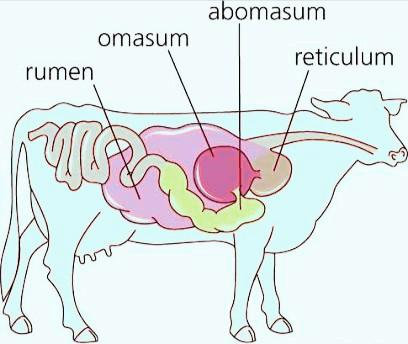
Herbivorous animals can digest cellulose because
(a) Their molar and premolar teeth can crush and grind the food.
(b) Bacteria present in their caecum help in the digestion of cellulose.
(c) Gastric juice has a digestive enzyme for cellulose digestion.
(d) The alimentary canal is short.
Answer
498k+ views
Hint: Digestion of cellulose occurs in the process of fermentation, which happens in anaerobic conditions.
Complete answer:
The stomach of herbivores more specifically the ruminants has four parts or four different chambers. In one part named rumen, some symbiotic microorganisms are present, which include bacteria like Rumenococcus and ciliates like Entodinium caudatum. These symbiotic microorganisms help in fermentation and breakdown of cellulose and thus help in their digestion.
Additional Information:
The parts of the digestive system of ruminants and their features are as follows:
- Rumen- The largest portion of the stomach is the rumen. This region contains villi with a cornified surface that helps in breaking and churning of food.
- Reticulum- The surface of the reticulum is lined by a stratified keratinized epithelium.
- A systematic and ordered contraction relaxation occurs between the rumen and reticulum which helps in mixing and churning the food substance. It also helps in regurgitation and passing of food onto the omasum.
- Omasum: This region is specialized for mixing and breaking down ingested food substances.
- Abomasum: Gastric juices are secreted from abomasum and it helps in biochemical digestion of food.
So, the correct answer is, "Herbivorous animals can digest cellulose because of bacteria present in their caecum help in the digestion of cellulose."
Note: Rumen and reticulum are specialized for food storage and while the food is stored inside them, the symbiotic microorganisms help in the breakdown of glucose, but the abomasum is known as the true stomach as the majority of biochemical digestion occurs here.
The structures where food is stored in the rumen and reticulum are known as water pockets or diverticula.

Complete answer:
The stomach of herbivores more specifically the ruminants has four parts or four different chambers. In one part named rumen, some symbiotic microorganisms are present, which include bacteria like Rumenococcus and ciliates like Entodinium caudatum. These symbiotic microorganisms help in fermentation and breakdown of cellulose and thus help in their digestion.
Additional Information:
The parts of the digestive system of ruminants and their features are as follows:
- Rumen- The largest portion of the stomach is the rumen. This region contains villi with a cornified surface that helps in breaking and churning of food.
- Reticulum- The surface of the reticulum is lined by a stratified keratinized epithelium.
- A systematic and ordered contraction relaxation occurs between the rumen and reticulum which helps in mixing and churning the food substance. It also helps in regurgitation and passing of food onto the omasum.
- Omasum: This region is specialized for mixing and breaking down ingested food substances.
- Abomasum: Gastric juices are secreted from abomasum and it helps in biochemical digestion of food.
So, the correct answer is, "Herbivorous animals can digest cellulose because of bacteria present in their caecum help in the digestion of cellulose."
Note: Rumen and reticulum are specialized for food storage and while the food is stored inside them, the symbiotic microorganisms help in the breakdown of glucose, but the abomasum is known as the true stomach as the majority of biochemical digestion occurs here.
The structures where food is stored in the rumen and reticulum are known as water pockets or diverticula.

Recently Updated Pages
Glucose when reduced with HI and red Phosphorus gives class 11 chemistry CBSE

The highest possible oxidation states of Uranium and class 11 chemistry CBSE

Find the value of x if the mode of the following data class 11 maths CBSE

Which of the following can be used in the Friedel Crafts class 11 chemistry CBSE

A sphere of mass 40 kg is attracted by a second sphere class 11 physics CBSE

Statement I Reactivity of aluminium decreases when class 11 chemistry CBSE

Trending doubts
10 examples of friction in our daily life

One Metric ton is equal to kg A 10000 B 1000 C 100 class 11 physics CBSE

Difference Between Prokaryotic Cells and Eukaryotic Cells

State and prove Bernoullis theorem class 11 physics CBSE

What organs are located on the left side of your body class 11 biology CBSE

How many valence electrons does nitrogen have class 11 chemistry CBSE




